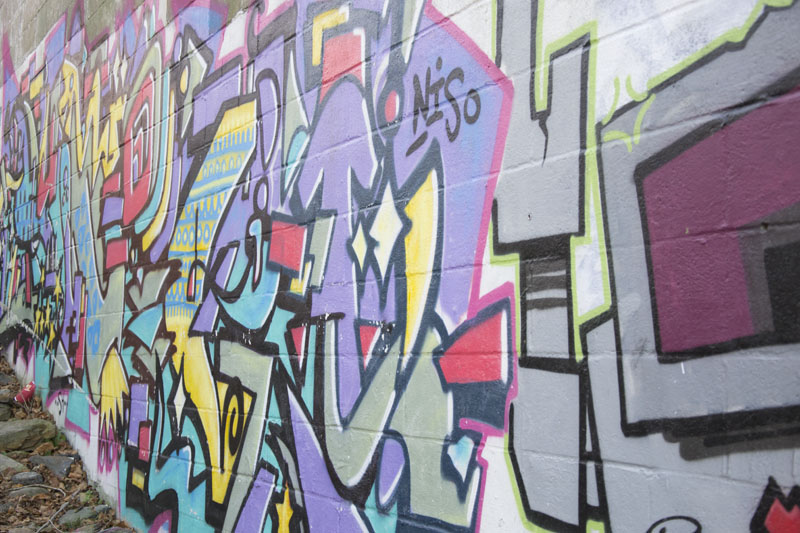Paint the town

Joe Cook waves a can of spray-paint back and forth in a rhythmic motion on the side of a building in North End Halifax. The outline of an old gas-station with a Model T-style car is already visible, part of a mural Cook and his Black Book Collective colleagues Michael Burt and Elliot Creba are painting on the side of C&R Auto Parts at the corner of Agricola and Charles.

Photos: Phil Moscovitch
Passersby stop and take photos. A few ask about painting techniques. A man in his 20s rides up on a skateboard and looks. “Looks good, man, looks good,” he says, fist-bumping Cook and rolling off.
Cook and Burt founded Black Book Collective in October 2014. They paint murals (including the one for slain basketball player Tyler Richards in Mulgrave Park) and sell spray-paint, jewelry, and vintage clothes out of a converted garage on Charles Street. They also have an outdoor wall lining the driveway that anyone is free to paint on.
“We are specifically tailored towards urban art, which is shunned in this city,” Cook says. “There’s nowhere in this city for people to go and do that kind of stuff.”
Talk about graffiti and people get passionate. Most agree that tagging, a quick hit in which someone paints a name on a wall, is unsightly, and that nobody should paint on homes or businesses without permission. But what about murals on businesses? Art on the sides of abandoned bridges and buildings? Providing free spaces for people to paint and develop their craft?
If you’re an up-and-coming graffiti artist, you don’t have a lot of options in Halifax. The only free wall on public property is at Dartmouth Cove at the end of a wall by the train tracks. While painting the wall is legal, standing by the tracks to do it is not.
“Think about it,” Cook says. “You’re a kid getting into graffiti and you start tagging. Then you want to try to do a really nice piece and you don’t have anywhere to go, you don’t have anywhere to practice. How do you expect kids to develop? That’s all I’m asking.”

Elora Wilkinson studied graffiti in Halifax for her 2014 master’s thesis in planning at Dalhousie. (She currently works on the city’s Centre Plan team, but did not speak to Halifax Magazine in that capacity). She says that the city used to have programs to engage youth in street art, but they are no more.
“The city had programs where they involved youth and created murals,” Wilkinson says. “It worked for graffiti management but also added some colour to the city. I think taking that program away and not adding any funding for street art was a large mistake. The public art we do get is very limited to physical pieces you can touch.”
Go to the Halifax tourism website and search for “murals” or “graffiti” and you’ll come up with nothing. A search for “art” spotlights Nocturne, individual galleries and Gingerbread Family Sunday at the AGNS.
Meanwhile, other cities are filling their streets with graffiti-style art, adding colour and attracting tourists. San Diego has a huge collection of murals in Chicano Park, Melbourne is known for its graffiti-filled laneways, and Montreal hosts two annual graffiti and mural festivals. (One of them was founded 20 years ago by now city councillor Sterling Downey, formerly known as the early 90s tagger SEAZ.)
And what’s the most recognizable alley in Toronto? Probably the one where Rick Mercer records his rants. You can learn all about it on the section of Toronto’s tourism site that promotes the city’s street art.
Uber5000 (“my friends call me Al”), a Nova Scotian who’s lived in Toronto since 2006, painted much of the art in that alley.

“Toronto’s got a lot of different businesses and companies starting up, so there’s always opportunities coming your way,” he says. “I have thought about moving back to Halifax, but there would be fewer opportunities to paint. In Halifax, the cops would always come and talk to you if you were spray-painting, even if it was legal. They’d come and harass you.”
Constable Gerry Murney sees no problem with that. He’s the Halifax Regional Police officer tasked with controlling graffiti. Specifically, what he calls “hip-hop graffiti,” a subject he talks about for two hours. Murney favours strict enforcement and seizing the assets of people who paint illegally.
“Legal graffiti is as intrusive and as bad as illegal graffiti,” he says. “It desensitizes the public to what they’re looking at, and it promotes the person [who painted it].” Cities like Montreal promoting graffiti baffle him. He says he thinks that providing places to paint legally is wrong-headed in that it promotes a culture inextricably tied up with drugs, alcohol, vandalism, and even suicide.
He tracks the local scene by monitoring Instagram, keeps a black book which currently has the names of 267 graffiti artists, and visits people and organizations to warn them about the dangers of graffiti.
When it comes to judging the acceptability of street art, Murney finds the question pretty simple. “Is it hip-hop graffiti? That’s destructive… We’re not going to promote or empower anybody who is associated with that culture. I hate to make an analogy, but we’re not going to sit around and watch the Hell’s Angels come in and give away Christmas gifts, right? They have ulterior motives.”

District 8 Councillor Lindell Smith doesn’t see it that way. He names some of his favourite murals in the city, and says he used to enjoy seeing the tags on the parking lot wall across from the Halifax North Memorial Library.
“It is a culture,” Smith says. “I don’t understand why so many people don’t like graffiti. If it’s done right, it’s actually kind of cool. Should there be more legal places? Yes. A place where people could do art and express themselves, that would be great.”
An open mind is required. “The people I mostly hear complaining about it don’t understand the culture,” he adds. “I would hate to be an entrepreneur, someone young, who found their art form and it got stigmatized and was considered a nuisance.”
Murney sometimes visits organizations that hire graffiti artists to do murals. After the Black Book Collective painted the side of the Estabrooks community hall in Hubley for free, he went to the Tantallon home of the organization’s board chair, Lorna Zinck-Gordon and urged her to call a special meeting of the board, which he addressed.
The episode puzzled Zinck-Gordon. “I don’t see any negative impact in our community from Black Book Collective,” she says. “As the owners of the building, we feel it’s a piece of artwork and we will continue having them there to repaint it. We’ve only had two people say they didn’t like it. We think it’s wonderful, and we don’t see any negative impact.”

Cook and Burt say that rather than contribute to vandalism, murals can prevent it. Part of the graffiti code of ethics is to not cover other people’s work, unless you’re going to go all out and outdo them. David Cheung, the owner of Bayer’s Road restaurant Look Ho Ho, says he was approached by Black Book to see if he’d be interested in having them paint a mural on the side of his building, which was perennially covered in tags. “It was bad,” Cheung says. There was always writing on it.” Six months after they painted the mural, it remains free of tags.
Linda Mosher, the strongest anti-graffiti voice on Council (she once complained to the library about a graffiti art program for kids) lost in the last election, and Smith has decidedly different views. It’s too soon to know what will change in the city’s policies, but in the meantime, Cook feels it’s unfair to blame people like him for vandalism.
“That would be like the police going to the liquor store every time someone has a drinking and driving accident,” he says. “I don’t condone someone tagging somebody’s windshield. I don’t condone someone tagging a mom-and-pop store. I don’t condone that shit.”
After a visit from Constable Murney, one young Halifax man—who wasn’t accused of doing anything illegal—gave up his art entirely. For his story and details on how Halifax police are now reconsidering their approach to graffiti, see Phil Moscovitch’s follow-up story.
This story was originally published in Halifax Magazine.









